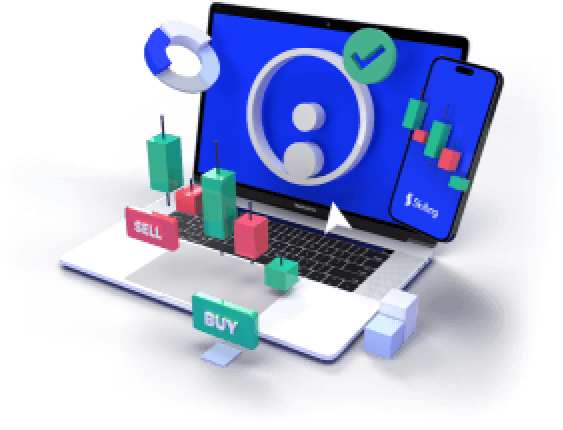Access 1,200+ global CFDs instruments.
Access a plethora of trading opportunities across the financial markets.

Access 1,200+ global CFDs instruments.
Access a plethora of trading opportunities across the financial markets.

What is a Lot?
In trading, a "lot" refers to the size of a transaction and is pivotal in managing both risk and potential profits. Essentially, it denotes the number of units of a financial instrument a trader buys or sells in one transaction. The definition of a lot can vary based on the market and the specific asset being traded.
For example, in forex, a standard lot typically represents 100,000 units of the base currency. In equities, the lot size often pertains to the number of shares traded at once. Various factors, such as the underlying asset and the exchange, can also influence lot sizes.
Understanding lot sizes is crucial for traders, as it helps in better risk management and enhances the likelihood of achieving desired profits.
How to calculate Lot size
Calculating lot size is vital for traders who wish to manage their risk and position size effectively. The calculation is influenced by the trader's account size, the instrument they are trading, and their personal risk tolerance.
To calculate lot size, consider the following factors:
- Account Size : It's generally advisable to risk no more than 1-2% of your account on each trade.
- Risk Tolerance : Establish how much of your account you’re willing to risk for each trade.
- Stop Loss Level : Determine your exit point if the market moves unfavorably.
Once these parameters are set, you can compute the lot size. Many trading platforms offer built-in calculators for this purpose.
Practice with a Demo Account
Try our demo account and experience real market conditions.

Example calculation:
- Account Size: $10,000
- Risk per Trade: 1%
- Stop Loss: 50 pips
- Currency Pair: EUR/USD
- Pip Value: $10
Lot Size = (Risk per Trade × Account Size) / (Stop Loss × Pip Value)
Lot Size = (1% × $10,000) / (50 × $10) = 0.2 lots
In the subsequent section, we’ll explore how to determine the appropriate lot size for various instruments, which will further enhance your trading strategy.
How to determine the correct Lot size
Different financial instruments come with unique tick sizes, contract sizes, and volatility levels, all of which can influence the appropriate lot size for a trade. Understanding these elements is key to determining the right lot size for each instrument.
In the forex market, trading is usually done in lots of 100,000 units. However, to accommodate various trader capital levels, brokers also offer mini lots (10,000 units) and micro lots (1,000 units).
Trade Demo: Real trading conditions with zero risk
Trade risk-free on Skilling’s award winning platforms with a 10k* demo account.

In the stock market, the lot size can vary by exchange; for instance, one standard lot in the U.S. market is typically 100 shares. In futures trading, the lot size depends on the specific contract, and in commodities trading, it varies based on the underlying asset.
Traders should also consider the volatility of each asset. Higher volatility instruments may necessitate smaller lot sizes for risk management, while more stable assets could allow for larger lot sizes.
What's your Trading Style?
No matter the playing field, knowing your style is the first step to success.

Applying Lot Size Calculation: Lot Size = (Risk Percentage × Account Balance) / (Value of 1 Pip)
| Example 1 | Example 2 |
|---|---|
| EUR/USD Assuming a $10,000 account balance and a risk percentage of 2%, the current exchange rate is 1.2000, with a trade size of 1 lot (100,000 units). The value of 1 pip would be $10. | Gold If you wish to trade gold with a $15,000 account and a risk percentage of 1.5%, where the current price of gold is $1,800 per ounce, and the stop loss is 50 points: |
| Lot Size = (2% × $10,000) / $10 = 20 lots. | Lot Size = (1.5% × $15,000) / $10 = 22.5 ounces |
Remember, accurately determining your lot size is crucial for maximizing potential profits while minimizing risks. Utilize the information and examples provided in this guide to make well-informed trading decisions.
What's your Trading Style?
No matter the playing field, knowing your style is the first step to success.

FAQs
1. How do I calculate lot size for a CFD trade?
To determine the lot size for a CFD trade, consider the instrument’s tick size, margin requirements, and your account size.
2. What is the minimum lot size in forex trading?
The minimum lot size in forex trading is typically 0.01 lots, also known as a micro lot.
3. Can I adjust lot sizes during a trade?
Yes, traders can modify their lot sizes during a trade based on market conditions and risk management strategies.
4. How do I know what lot size to use?
The correct lot size is based on your account size, risk tolerance, and the volatility of the instrument. Online calculators can also assist in this determination.
5. What if I use a lot size too large for my account?
Using a lot size that exceeds your account capacity can lead to substantial losses and potential margin calls. It’s essential to choose appropriate lot sizes and implement risk management strategies.
6. Can I trade multiple instruments with the same lot size?
While it's possible to use the same lot size across different instruments, it’s not advisable due to the varying volatility and pip values associated with each asset.











